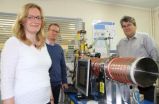(Press-News.org) Researchers reveal how the alteration of a single nucleotide—the basic building block of DNA—could initiate fragile X syndrome, the most common inherited form of intellectual disability. The study appears in The Journal of Cell Biology.
Fragile X syndrome is caused by a defect in a gene on the X chromosome called fragile X mental retardation 1 (FMR1). Around 1 in 230 women and 1 in 360 men carry a so-called premutation, in which a series of DNA repeats at one end of the FMR1 gene is slightly longer than normal. These repeats are prone to even further expansion when FMR1 is passed from mother to child, causing the gene to switch off and stop producing a protein that is important for some cognitive functions.
A group of researchers from
Albert Einstein College of Medicine of Yeshiva University in New York previously found that a certain site that initiates DNA replication, located near to the FMR1 gene, is inactivated in fragile X embryonic stem cells. This inactivation changes the way that the FMR1 gene is copied during cell division, which could pose problems that lead to expansion of the DNA repeats within the gene.
Intriguingly, a specific alteration in the DNA sequence near the FMR1 gene—a "single-nucleotide polymorphism" or SNP— has been linked to an increased risk of repeat expansion in some premutation carriers. These researchers discovered that this SNP overlaps with the inactive replication origin in fragile X embryonic stem cells.
Nucleotides in DNA include one of four bases (cytosine, thymine, adenine, or guanine). The researchers found that normal embryonic stem cells had a thymine base at the SNP site and an active replication origin. Fragile X cells, in contrast, had a cytosine base and an inactive origin. The researchers also derived embryonic stem cells from mothers carrying the fragile X premutation. These cells had a thymine base and a normal replication pattern and, accordingly, showed no tendency to expand their repeat numbers over time.
The findings show that the substitution of cytosine for thymine might inactivate the DNA replication origin when the FMR1 gene is passed from mother to child, increasing the risk of DNA repeat expansions that can lead to fragile X syndrome.
INFORMATION:
Gerhardt, J., et al. 2014. J. Cell Biol. doi:10.1083/jcb.201404157
About The Journal of Cell Biology
The Journal of Cell Biology (JCB) is published by The Rockefeller University Press. All editorial decisions on manuscripts submitted are made by active scientists in conjunction with our in-house scientific editors. JCB content is posted to PubMed Central, where it is available to the public for free six months after publication. Authors retain copyright of their published works, and third parties may reuse the content for non-commercial purposes under a creative commons license. For more information, please visit http://www.jcb.org.
Research reported in this press release was supported by the National Institute of General Medical Sciences and National Institute of Child Health and Human Development of the National Institutes of Health, Empire State Stem Cell Fund, Starr Tri-Institutional Stem Cell Initiative, and Neurogenomics.
A nucleotide change could initiate fragile X syndrome
2014-09-01
ELSE PRESS RELEASES FROM THIS DATE:
Scientists call for investigation of mysterious cloud-like collections in cells
2014-09-01
WASHINGTON — About 50 years ago, electron microscopy revealed the presence of tiny blob-like structures that form inside cells, move around and disappear. But scientists still don't know what they do — even though these shifting cloud-like collections of proteins are believed to be crucial to the life of a cell, and therefore could offer a new approach to disease treatment.
In the Journal of Cell Biology, two researchers are issuing a call to investigators from various backgrounds, from biophysics to cell biology, to focus their attention on the role of these formations— ...
Zooming in for a safe flight
2014-09-01
As nocturnal animals, bats are perfectly adapted to a life without light. They emit echolocation sounds and use the delay between the reflected echoes to measure distance to obstacles or prey. In their brains, they have a spatial map representing different echo delays. A study carried out by researchers at Technische Universität München (TUM) has shown for the first time that this map dynamically adapts to external factors.
Closer objects appear larger
When a bat flies in too close to an object, the number of activated neurons in its brain increases. As a result, ...
Week-long meeting on naming algae, fungi, and plants recorded for posterity
2014-09-01
The week-long discussions and decisions of the Nomenclature Section of the XVIII International Botanical Congress took place in Melbourne, Australia in July 2011. This meeting is held every six years and it is where the world's premier experts on the rules for naming algae, fungi and plants get together to debate and update the rule book for naming the organisms they study. This is the primary product of the meeting, the International Code of Nomenclature for algae, fungi, and plants, which was published in 2012. The other important product is the official report for the ...
Scientists get set for simulated nuclear inspection
2014-09-01
Some 40 scientists and technicians from around the world will descend on Jordan in November to take part in a simulated on-site inspection of a suspected nuclear test site on the banks of the Dead Sea.
Playing the part of inspectors, the experts will have access to a wide range of sensor technologies to look for signs of whether a nuclear explosion has taken place. At the same time, other role-players representing the state under inspection will try to put them off their scent.
The aim of this elaborate exercise, as science writer Edwin Cartlidge explains in this month's ...
Invisible blood in urine may indicate bladder cancer
2014-09-01
New research which finds that invisible blood in urine may be an early warning sign of bladder cancer is likely to shape guidelines for clinicians.
Scientists at the University of Exeter Medical School found that one in 60 people over the age of 60 who had invisible blood in their urine (identified by their GP testing their urine) transpired to have bladder cancer. The figure was around half those who had visible blood in their urine – the best known indicator of bladder cancer. However, it was still higher than figures for other potential symptoms of bladder cancer ...
Sugar substance 'kills' good HDL cholesterol, new research finds
2014-09-01
Scientists at the University of Warwick have discovered that 'good' cholesterol is turned 'bad' by a sugar-derived substance.
The substance, methylglyoxal - MG, was found to damage 'good' HDL cholesterol, which removes excess levels of bad cholesterol from the body.
Low levels of HDL, High Density Lipoprotein, are closely linked to heart disease, with increased levels of MG being common in the elderly and those with diabetes or kidney problems.
Supported by funding from the British Heart Foundation (BHF) and published in Nutrition and Diabetes, the researchers ...
New tuberculosis blood test in children is reliable and highly specific
2014-09-01
A new blood test provides a fast and accurate tool to diagnose tuberculosis in children, a new proof-of-concept study shows. The newly developed test (TAM-TB assay) is the first reliable immunodiagnostic assay to detect active tuberculosis in children. The test features excellent specificity, a similar sensitivity as culture tests in combination with speed of a blood test. The promising findings are a major advance for the diagnosis of tuberculosis in children, particularly in tuberculosis-endemic regions.
The study has been published on Sept 1st, 2014 in Lancet Infectious ...
Scientists develop 'electronic nose' for rapid detection of C. diff infection
2014-09-01
A fast-sensitive "electronic-nose" for sniffing the highly infectious bacteria C. diff, that causes diarrhoea, temperature and stomach cramps, has been developed by a team at the University of Leicester.
Using a mass spectrometer, the research team has demonstrated that it is possible to identify the unique 'smell' of C. diff which would lead to rapid diagnosis of the condition.
What is more, the Leicester team say it could be possible to identify different strains of the disease simply from their smell – a chemical fingerprint - helping medics to target the particular ...
Why plants in the office make us more productive
2014-09-01
'Green' offices with plants make staff happier and more productive than 'lean' designs stripped of greenery, new research shows.
In the first field study of its kind, published today, researchers found enriching a 'lean' office with plants could increase productivity by 15%.
The team examined the impact of 'lean' and 'green' offices on staff's perceptions of air quality, concentration, and workplace satisfaction, and monitored productivity levels over subsequent months in two large commercial offices in the UK and The Netherlands.
Lead researcher Marlon Nieuwenhuis, ...
Doctor revalidation needs to address 7 key issues for success, claims report
2014-09-01
New research launched today, 1st September 2014, has concluded that there are seven key issues that need to be addressed to ensure the future success of doctor revalidation, the most profound revision in medical regulation since the Medical Act of 1858.
The research has been funded by the Health Foundation, an independent health care charity, as part of a long-term programme looking at different aspects of revalidation. The work has been carried out by academics at the Collaboration for the Advancement of Medical Education, Research and Assessment (CAMERA) at Plymouth ...



